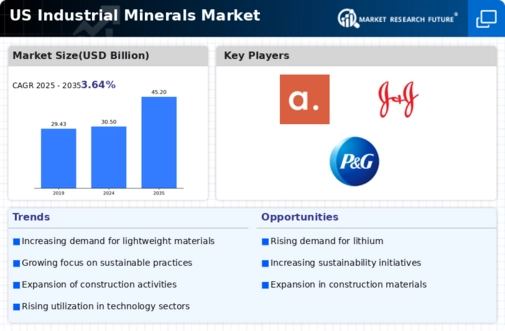The competitive landscape of the US Industrial Minerals Market is characterized by a dynamic interplay of various factors that shape the industry's performance and the strategies of key players. Industrial minerals, which encompass a wide range of naturally occurring materials such as clays, feldspar, gypsum, limestone, and silica, play a crucial role in numerous applications spanning from construction and manufacturing to agriculture and environmental remediation.
The market is influenced by factors such as technological advancements, regulatory frameworks, and changes in consumer demand, leading to an ongoing need for companies to innovate and differentiate their offerings. Each participant in the market seeks to establish a robust presence by leveraging their unique strengths, operational efficiencies, and pathways for growth, which often include strategic partnerships and investments in research and development.
Caribbean Cement Company has established a significant foothold in the US Industrial Minerals Market, primarily recognized for its proficiency in producing high-quality cements and related products. The company benefits from strategically located production facilities, allowing it to efficiently serve regional markets while maintaining competitive pricing.
Caribbean Cement Company's commitment to sustainability and innovation has enhanced its reputation among industry stakeholders, as they continually seek to reduce environmental impacts through the development of more eco-friendly manufacturing processes and products.
Moreover, their strong customer relationships and extensive distribution networks provide them with an advantage in meeting the diverse needs of clients, thereby positioning them favorably against competitors in the industrial minerals sector.
Pioneer Natural Resources maintains a prominent position within the US Industrial Minerals Market through its diversified portfolio of natural resources and effective management of land and minerals. The company is recognized for its key offerings, which are primarily associated with mineral exploration and extraction, underpinned by its expertise in various geological formations.
Pioneer Natural Resources focuses on delivering high-quality industrial minerals that cater to several applications, significantly contributing to sectors like construction and infrastructure. The company's strength in the market is further bolstered by its strategic acquisitions, which enhance its resource base and operational capacity.
This proactive approach, combined with a commitment to operational excellence and sustainability, cements Pioneer Natural Resources' role as a pivotal player in the US Industrial Minerals Market, ensuring it is well-positioned to meet the evolving needs of the industry.














Leave a Comment